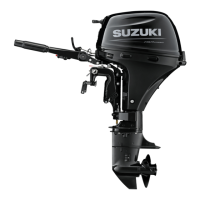21
3. Lower the motor back down.
To lower the bow, move the pin towards the
boat. To raise the bow, move the pin away from
the boat.
WARNING
Trim angle greatly affects steering stability. If
the trim angle is too small, the boat may
“plow” or “bow steer”. If the trim angle is too
large, the boat may “chine walk” from side to
side or “porpoise” up and down. These condi-
tions, which result in loss of steering control,
can cause occupants to be thrown overboard.
Always maintain proper trim angle based on
the combination of your boat, engine, and pro-
peller, as well as operating conditions.
WARNING
If you operate the motor with the tilt pin
removed, you may not be able to control steer-
ing as expected.
Do not operate the motor with the tilt pin
removed.
STEERING TENSION ADJUSTMENT
The steering on your outboard motor should be
smooth and not tight. Adjust the steering ten-
sion so that there is only a slight resistance to
steering movement.
REMOTE CONTROL MODEL
To increase the steering tension, turn the steer-
ing tension bolt A clockwise. To decrease the
steering tension, turn the steering tension bolt
counterclockwise.
TILLER HANDLE MODEL
To increase the steering tension, turn the steer-
ing tension bolt A clockwise. To decrease the
steering tension, turn the steering tension bolt
counterclockwise.
For auxiliary adjustment, use the steering ten-
sion lever B. To increase the steering tension,
move the lever B to the left. To decrease the
steering tension, move the lever to the right.
NOTE:
• To adjust initial steering friction, use the
steering tension bolt A with the steering ten-
sion lever B positioned right fully.
• Do not apply a grease to the area C.

